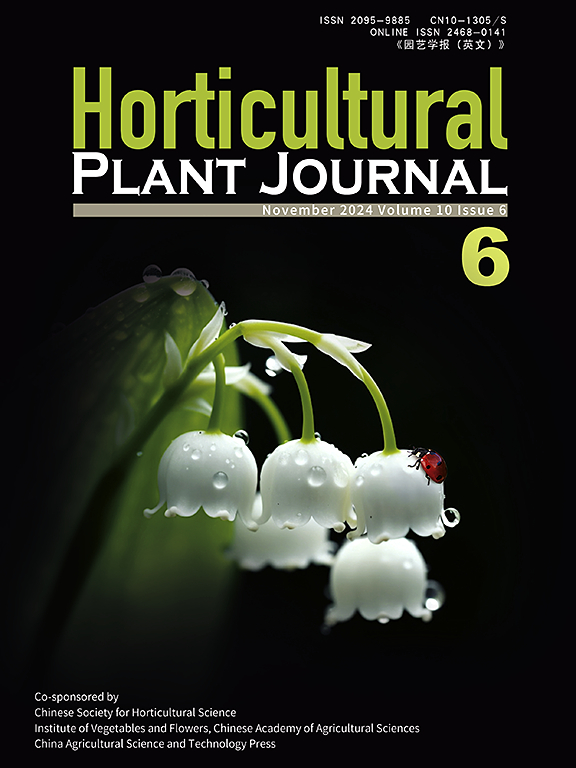与甘蓝(Brassica oleracea var. capitata)头叶形成相关的 miRNA 调控基因的表达变化。
IF 5.7
1区 农林科学
Q1 HORTICULTURE
引用次数: 0
摘要
卷心菜(变种)是一种具有重要经济价值的蔬菜作物,因其头顶长叶而得名。卷心菜植株的无性系发育经历了幼苗期、莲座期、折叠期和头状花序期。莲座期的叶片大而扁平,是主要的光合器官。在接下来的发育阶段,植株长出的叶片向内弯曲,与嫩枝先端重叠,形成多叶的头状花序。这些叶片可以遮挡光线,是吸收器官。我们研究了 miRNA 调控基因在莲座期向头状花序期过渡中的作用。我们首先对两种截然不同的(圆头和尖头)头状甘蓝形态的叶片形成和扩展进行了表型分析,以确定莲座期和头状期的发育阶段。这样,我们就能收集分别发育成莲座期和茎叶期的膨大幼叶组织,进行 miRNA 和基因表达分析。我们用两个时间点的非打头的油麦菜(变种)形态型的嫩叶组织作为对照,以区分调控植物年龄的转录本(miRNAs/基因)与确定白菜从莲座叶向打头叶过渡的转录本(miRNAs/基因)。对于圆白菜和尖头白菜,我们比较了莲座叶和顶芽叶的 miRNA 和 mRNA 丰度,以确定差异表达的 miRNA(DEMs)和基因(DEGs)。在校正了与植株年龄相关的 miRNA 和基因后,我们确定了 33 个 DEM 和 1,998 个 DEGs,它们在莲座期向顶芽期的过渡中发挥作用。我们预测了这33个DEMs的靶基因,并重点研究了莲座期叶片和茎秆期叶片之间的DEGs子集,从而构建了miRNA-靶基因相互作用网络。我们的主要发现是,miR396b-5p靶向()和-()的两个直向同源物,在尖头甘蓝头部形成中发挥作用。本文章由计算机程序翻译,如有差异,请以英文原文为准。
Expression changes of miRNA-regulated genes associated with the formation of the leafy head in cabbage (Brassica oleracea var. capitata).
Cabbage ( var. ) is an economically important vegetable crop grown for its leafy head. Cabbage plants’ vegetative development goes from seedling to rosette, folding and heading stages. Leaves that form the rosette are large and mostly flat, acting as the major photosynthetic organs. In the following developmental stages, the plants produce leaves that curve inward, overlapping the shoot apex to produce the leafy head. These leaves are shielded from the light and act as sink organs. We investigated the role of miRNA-regulated genes in the transition from the rosette to the heading stage. We first phenotyped leaf formation and -expansion for two contrasting (round and pointed) heading cabbage morphotypes to define the rosette and heading developmental stages. This allowed us to collect tissue from young expanding leaves that would develop into, respectively, rosette and heading leaves for miRNA and gene expression analyses. Young leaf tissue of two time points of a non-heading collard green ( var. ) morphotype was used as a control to distinguish the transcripts (miRNAs/genes) that regulate plant age from those defining the transition from rosette to heading leaves in cabbages. For both round and pointed cabbages, we compared the miRNA and mRNA abundances between rosette and heading leaves to identify differentially expressed miRNAs (DEMs) and –genes (DEGs). After correcting for miRNAs and genes related to plant age, we identified 33 DEMs and 1,998 DEGs with roles in the transition from rosette to heading stage. We predicted the target genes of these 33 DEMs and focused on the subset that were DEGs between rosette and heading stage leaves to construct miRNA-target gene interaction networks. Our main finding is a role for miR396b-5p targeting two orthologues of () and - () in pointed cabbage head formation.
求助全文
通过发布文献求助,成功后即可免费获取论文全文。
去求助
来源期刊

Horticultural Plant Journal
Environmental Science-Ecology
CiteScore
9.60
自引率
14.00%
发文量
293
审稿时长
33 weeks
期刊介绍:
Horticultural Plant Journal (HPJ) is an OPEN ACCESS international journal. HPJ publishes research related to all horticultural plants, including fruits, vegetables, ornamental plants, tea plants, and medicinal plants, etc. The journal covers all aspects of horticultural crop sciences, including germplasm resources, genetics and breeding, tillage and cultivation, physiology and biochemistry, ecology, genomics, biotechnology, plant protection, postharvest processing, etc. Article types include Original research papers, Reviews, and Short communications.
 求助内容:
求助内容: 应助结果提醒方式:
应助结果提醒方式:


